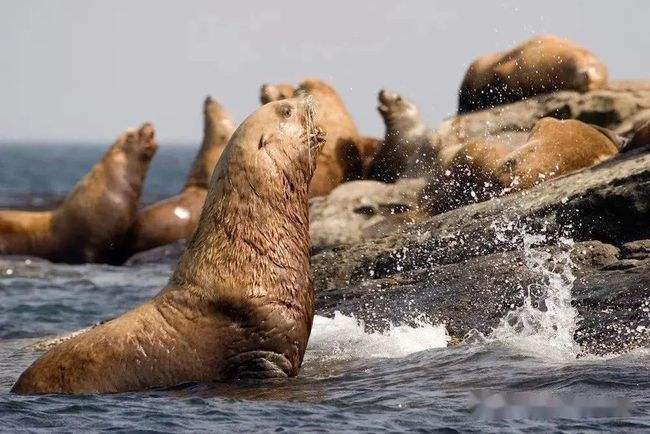Eumetopias jubatus
IUCN
LCBasic Information
Scientific classification
- name:Eumetopias jubatus
- Scientific Name:Eumetopias jubatus,Northern Sealion,North Pacific sea lion, Stevens sea lion, sea donkey
- Outline:Carnivora
- Family:Pinnipeds E.lions S.lion
Vital signs
- length:250-350cm
- Weight:300-1000kg
- lifetime:
Feature
It is the largest species of sea lion and is known as the "King of Sea Lions".
Distribution and Habitat
Steller sea lions are distributed in the Pacific Ocean (Bering Sea, Sea of Okhotsk, Alaska, Kamchatka, Aleutian Islands and Beigan Island, etc.), and are found in the Yellow Sea in Qidong, Jiangsu and the Bohai Sea in Dalian, Liaoning in China.
Steller sea lions generally live in cold temperate coastal waters and do not have fixed habitats except during the breeding season.
Appearance
The body is slender and spindle-shaped, with a slightly concave top of the head, a long neck, a short and wide face, a blunt snout, and large eyes. It has external auricles, which are relatively short and close to the side of the head. Both the front and rear limbs are paddle-shaped, with the front limbs longer than the hind limbs, the first toe is the longest, and the claws of each toe are degenerate. The hind limbs can bend forward from the ankles, the first and fifth toes are longer, but the claws are degenerate, and the middle three toes are short, but the claws are well-developed. The ends of the limbs are exposed, with a small and clear tail and a very small scrotum.
The body shape of male and female northern sea lions is very different. As males grow, long bristle-like hair gradually grows on their necks, but there is no fluff. The body is mainly yellow-brown, with a darker color from the chest to the abdomen, and the body color of females is slightly lighter than that of mal
Details
The northern sea lion is called Northern Sealion in foreign language. It is the largest species of sea lion family and has 2 subspecies.

The northern sea lion is gentle and likes to gather in groups. Swimming and diving mainly rely on their long forelimbs. Occasionally, they will climb ashore to bask in the sun and sleep on the shore at night. When they are on the shore, the northern sea lion is very alert. Its courage is very disproportionate to its huge body. Once there is any disturbance, it will quickly return to the sea. Even when sleeping, there are "sentinels" in the group to serve as guards. If they find danger, they will immediately send a signal to inform their companions. The "sentinels" are very serious about the guard work. They look up and look around, listening to the sound and smelling the smell. Even the cry of seagulls can cause them fear and flee in panic. Sometimes they will approach fishing boats without hesitation, but once they sense danger, they will quickly move away and then roar loudly to intimidate.
The vision of the northern sea lion is poor, but the hearing and smell are very sensitive, especially at the base of the whiskers, which are crisscrossed with nerves. It not only has a strong sense of touch, but also is a sound receptor with high precision. It can emit a series of sound signals to the surroundings, and then collect the echoes returned from the target to determine the size and shape of the target, so as to accurately identify the object.
The northern sea lion is the most important member of the sea lion family and is known as the "king of sea lions". The sea lion is an animal with high application value. It plays an important role in both science and military. The northern sea lion is naturally smart and clever, comparable to dolphins. Under careful training by humans, it can replace divers to salvage underwater relics, conduct underwater military reconnaissance and underwater rescue, etc. It has been incorporated into the special forces of the US Navy. It can also live in fresh water, and its balance organs are particularly developed. In the zoo, it can perform superb skills such as using its nose to head the ball, shooting, drilling through hoops, standing up with its hind legs, holding things with its lower jaw, standing up with its forelimbs and walking upside down. It can even jump over a rope 1.5 meters above the water surface. Once these skills are learned, they can still be performed in the same way after a few years. After the performance, they can also shake hands with the audience, so they are deeply loved by people. However, because of its thin skin and full of hard hair, its economic value is not great.
According to surveys, there were 27,286 northern sea lions in the Gulf of Alaska and the Bering Sea in 1992, and only 22,167 in 1996, which was about 1/3 lower than around 1980, but the population of this species is on the rise. In 2004, the estimated total number in the world was 250,000 to 300,000.
Listed in the IUCN Red List of Threatened Species in 2016 ver 3.1 - Near Threatened (NT).
Listed in China's National List of Key Protected Wildlife (February 5, 2021) Level 2.
Protect wildlife and eliminate game.
Maintaining ecological balance is everyone's responsibility!








